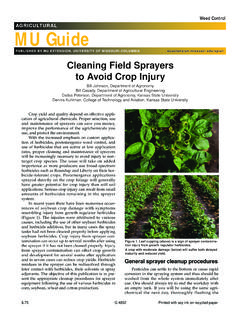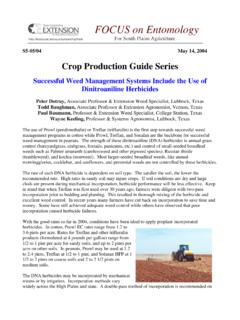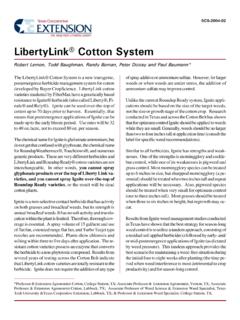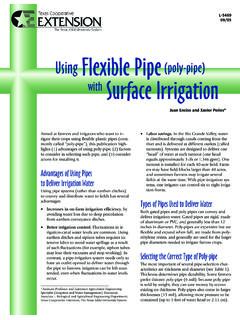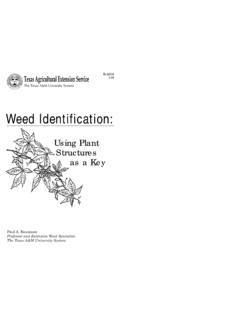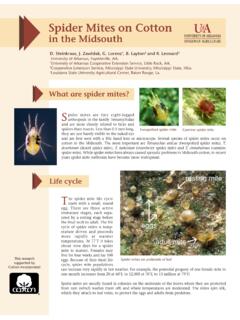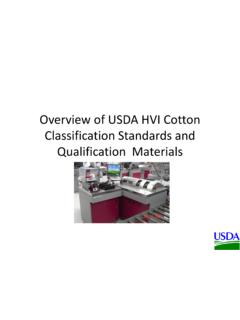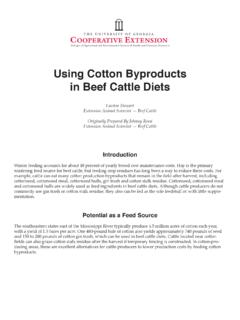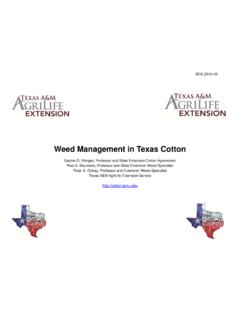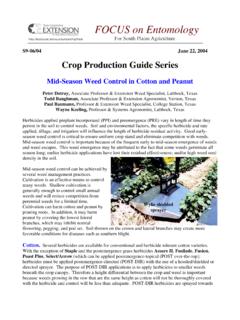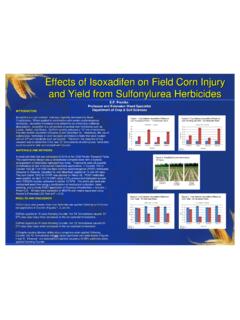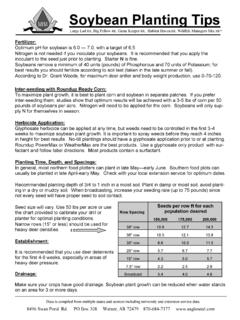Transcription of Crop Production Guide Series - cotton.tamu.edu
1 S11-08/04 August 27, 2004 Crop Production Guide Series Late Season Weed Control in Cotton and Peanut Peter Dotray, Associate Professor & Extension Weed Specialist, Lubbock, Texas Todd Baughman, Associate Professor & Extension Agronomist, Vernon, Texas Paul Baumann, Professor & Extension Weed Specialist, College Station, Texas Wayne Keeling, Professor & Systems Agronomist, Lubbock, Texas Late-season weed control is important to reduce harvest losses caused by weeds, decrease weed seed and underground reproductive storage Production , and help reduce annual and perennial weed populations in the spring. Late season inputs should be based on these factors and not based on the assumption that yield will be reduced by competition from these late season weeds, unless they impair machine harvest. Good early- and mid-season weed control is critical for stand establishment and to eliminate competition with weeds. The use of residual herbicides and properly timed postemergence herbicides will pay off in wet years that support several flushes of weeds.
2 Even under ideal weed management programs, late-season, pre-, and post-harvest weed control in cotton and peanut may be necessary to finish the crop and start weed management for the following growing season. Herbicides used late season in cotton and peanut must be used according to the pre-harvest interval (PHI) listed on the label. Cotton. In Roundup Ready (RUR) cotton, glyphosate may be applied by aerial or ground application equipment at rates up to 22 ounces per acre of Roundup WeatherMax or 32 ounces of a 4 lb. glyphosate material from ground crack to the 4-leaf stage (until the fifth true leaf reaches the size of a quarter). Over-the-top applications made after the 4-leaf stage of development may result in boll loss, delayed maturity, and/or yield loss. According to the Salvage Treatment section of the Roundup WeatherMax label, treatments made over-the-top after the 4-leaf stage should only be used where weeds threaten to cause the loss of the cotton crop. Twenty-two ounces of Roundup WeatherMax may be applied either as an over-the-top or post-emergence-directed treatment sprayed higher on the cotton plants and over the weeds.
3 SALVAGE TREATMENTS WILL RESULT IN SIGNIFICANT BOLL LOSS, DELAYED MATURITY AND/OR YIELD LOSS. NO MORE THAN ONE SALVAGE TREATMENT SHOULD BE USED PER GROWING SEASON. Glyphosate may be applied for pre-harvest control of annual and perennial weeds as a broadcast treatment to RUR cotton after 20 percent boll crack. Up to 44 ounces of Roundup WeatherMax or 64 ounces of a 4 lb glyphopsate material may be applied using either aerial or ground spray equipment. Glyphosate will not enhance the performance of harvest aids when applied to RUR cotton. For LibertyLink cotton, 32 to 40 ounces of Ignite may be used per application and up to 80 ounces may be used per year. Effective weed control will depend on thorough spray coverage made to small weeds. Avoid drift onto non-LibertyLink cotton. Do not apply Ignite within 70 days prior to cotton harvest. In conventional cotton (and transgenic cotton), glyphosate may be applied through hooded sprayers, recirculating sprayers, shielded applicators or wiper applications (rope or sponge wick).
4 It is important to avoid leakage of spray mists or dripping of herbicide solution onto cotton. Wiper applicators take advantage of a height differential between cotton and weeds. This equipment physically wipes the spray solution directly onto the foliage of the weeds and not on the crop. This equipment should be operated no greater than 5 miles per hour. Performance will be improved by slowing down in areas of dense weed infestations. A second application may be necessary and should be made in the opposite direction. Spray solutions from 33 to 100 percent should be used. Mix only the amount of solution to be used during a 1-day period, since leftover solutions may be less effective over time. Do not use wiper equipment when weeds are wet and do not add a surfactant to the herbicide solution. Clean weed foliage and non-stressed weeds will be controlled more effectively than dirty, stressed weeds. For spot treatments, apply this product prior to boll opening. Do not treat more than 10% of the total field area to be harvested.
5 Non-transgenic cotton receiving spray solution will be killed. Care must be taken to avoid drift or spray outside the target area. The presence of late-season weeds may not always justify a herbicide treatment. This is especially true if the weed presence in the field is low and will not affect harvest efficiency or result in harvest losses. Weed competition is not near at a premium during this time of the year, and an economic benefit may not be realized from applying herbicide at this time. In addition a pre-harvest herbicide application may be all that is needed to dry weeds down and allow for a minimal amount of loss at harvest. Pigweed in Cotton The postemergent grass products may be applied over-the-top of cotton to control certain grassy weeds. The following pre-harvest interval is in effect for each of these herbicides: Fusilade DX and Fusion - 90 days prior to harvest, Select/Arrow - 60 days prior to harvest, and Poast/Poast Plus - 40 days prior to harvest. Apply these herbicides with a crop oil concentrate at 1 qt/A.
6 See label recommendations to determine amount to apply, weed size, and maximum use rate per season. For late-planted cotton, in which both the cotton and weeds are small, there may be a benefit from a layby application. For reference on layby applications, see the Focus on Entomology Crop Production Guide Series S9-06/04 entitled Mid-Season Weed Control in Cotton and peanut located on the Lubbock website. Peanut. The options for late season weed control are limited in peanut. Non-selective herbicides are not an option because heavy leaf loss and dead stems will weaken pegs and result in heavy pod loss. A combination of 2,4-DB, Blazer/Ultra Blazer, and Crop Oil Concentrate are often most effective in controlling larger escaped weeds. However, the pre-harvest interval for Blazer is 75 days. This would result in peanuts being harvested after November 1st, which is also not advisable. A 2,4-DB may be applied at up to pints per acre. Do not apply later than 100 days after planting or 30 days before harvest.
7 Basagran may be applied at rates up to 2 pints per acre. The maximum weed size on the label is 10 inches for highly susceptible weeds such as cocklebur. This herbicide will be ineffective on weeds such as pigweed (carelessweed). Read the label to determine weed species and maximum size of weeds that will be controlled. Residual herbicides such as Cadre and Pursuit should not be applied this late in the season since this will result in rotational crop problems the following year. Select may be applied to control grassy weeds at rates of 6 to 16 fl oz/A (total of 32 fl oz/A per season). For grasses that exceed the height on the label, Select may be applied at rates of 16-to 32 fl oz/A in an effort to suppress grassy weeds and improve harvest efficiency (See supplemental label). Poast may be applied at a rate of pt/A per application (total of pt/A per season) for control of certain grassy weeds. Apply both Select and Poast with a crop oil concentrate at 1 qt/A. Neither of these products can be applied within 40 days of peanut harvest.
8 See label for specific grasses controlled, grass size, and herbicide rate. Glyphosate applied through a wiper application (rope or sponge wick) is also an option in peanut. In fact, it may be easier in peanut since the needed height differential between the crop and weeds is more easily achieved. See comments about this type of application in the cotton section above. Grassy weeds in peanut Silverleaf nightshade in peanut Crop Production Guide Series , a supplement to FOCUS on Entomology newsletter, is published by Texas Cooperative Extension Route 3, Box 213AA Lubbock, TX 79403 Fair Use Policy for FOCUS information: We do not mind if others use the information in FOCUS for their own purposes, but please give FOCUS the appropriate credit when you do. Images may or may not be copyrighted by the photographer or an institution. They may not be reproduced without permission. Call 806-746-6101 to determine the copyright status of images. Editor: James F. Leser Associate Editor & Graphic Designer: Michelle Coffman For more information call or e-mail: 806-746-6101 or Educational programs conducted by Texas Cooperative Extension serve people of all ages regardless of socio-economic level, race, color, sex, religion, handicap or national origin.
9 References to commercial products or trade names is made with the understanding that no discrimination is intended and no endorsement by Texas Cooperative Extension is implied.
